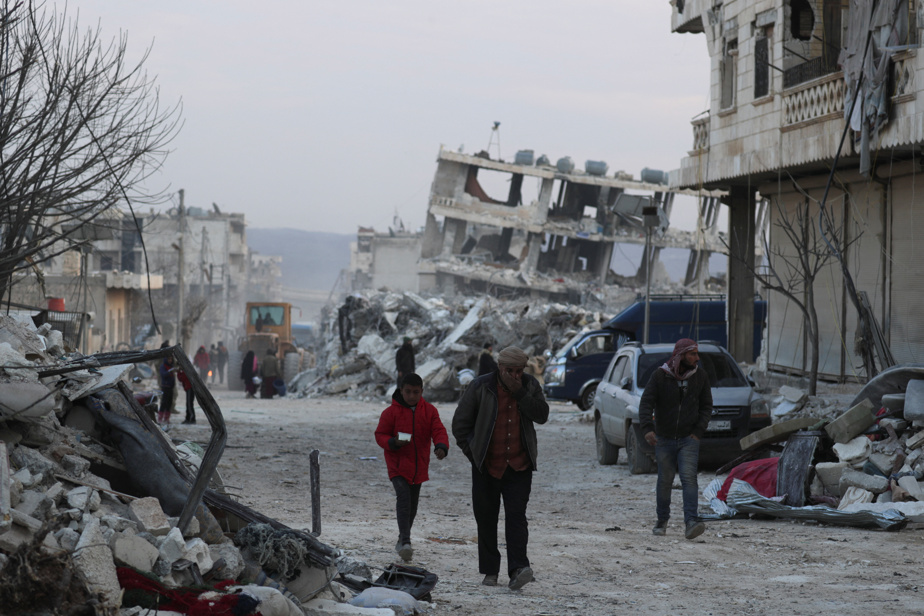Since the February 6 earthquake in northwestern Syria, dignitaries from the region have come and gone to offer their support, in this country already devastated by more than 10 years of conflict. Syrian President Bashar al-Assad finds himself at the forefront of these visits. A situation decried by its opponents, who fear a normalization of relations with the regime, ostracized for a decade for the treatment of its population.
“The Syrian regime is benefiting from this situation now,” said Muzna Dureid, an analyst and Syrian refugee based in Montreal. He takes the opportunity to say that it is a natural disaster and that the international community must also have relations with him, because it is the Syrian government. But this is not true. »
The quake hit southern Turkey – home to a large population of Syrian refugees – and northwestern Syria. The earthquake killed more than 50,000 people, including 6,000 in Syria, mainly in an area controlled by rebels and jihadists.

PHOTO PROVIDED BY SANA, AGENCE FRANCE-PRESSE ARCHIVES
Syrian President Bashar al-Assad on the ground to see the earthquake damage in Jablé on February 11
Some 3,000 members of the White Helmets on site participated in the rescue operations, said Mr.me Dureid, development officer for the civil defense group active in rebel areas.
But after more than 10 years of bombing and fighting, the region was already on its knees. The infrastructure is failing. Cholera set in in the fall.
Some 4 million Syrians live in the rebel area in the north and almost 90% depend on humanitarian aid, according to the United Nations.
“The situation is catastrophic, but now it’s worse,” says Mme Dureid. The challenges are always the lack of equipment, the lack of international aid. »
Hand held out
Faced with the magnitude of the needs, many countries and organizations have reached out. The head of Egyptian diplomacy, Sameh Shukri, traveled to Damascus on Monday, the first visit to Syria by a foreign minister from Cairo in more than 10 years.
-

PHOTO PROVIDED BY THE SYRIAN PRESIDENCY, AGENCE FRANCE-PRESSE
Syrian President Bashar al-Assad and Egyptian Foreign Minister Sameh Shukri in Damascus on February 27
-

PHOTO PROVIDED BY SANA, ASSOCIATED PRESS
Bashar al-Assad welcoming a delegation from the Arab Parliament, in Damascus, on February 26
-

PHOTO PROVIDED BY SANA, ASSOCIATED PRESS
UAE Foreign Minister Abdullah bin Zayed al-Nahyan and Bashar al-Assad in Damascus on February 12
1/3
A delegation of politicians from various Arab countries was welcomed by Bashar al-Assad in the capital on Sunday, confirming the hypothesis of a “thaw” in the relations of certain countries in the region with the regime diplomatically isolated since its violent repression of the popular uprisings of 2011, which quickly turned into a civil war.
Syria remains divided between the areas controlled by the regime of Bashar al-Assad, the majority, and the other regions, controlled by rebel fighters, Islamist militants or Kurdish forces.
The Syrian president has been decried on the international scene for his actions in the country against his people.
Iranian influence
“Regional normalization has been underway for a while,” notes Dareen Khalifa, senior analyst at the International Crisis Group. As far as Arab countries are concerned, there is a kind of division in positions on normalization. There are countries, like the United Arab Emirates, that have gone ahead with normalizing or restoring the relationship unconditionally. »
One way for them to try to counter the significant Iranian influence in Syria, she explains. “But it did not materialize and it is unlikely that it will have this consequence,” she adds.
Normalization is very limited to political and diplomatic visits and gestures. It did not manifest itself by an influx of money for the reconstruction of the country, as some thought.
Dareen Khalifa, senior analyst at the International Crisis Group
Western sanctions play a role in this restraint of governments that openly display themselves alongside Bashar al-Assad, she argues.
The American Caesar Act, for example, discourages investment by sanctioning companies or people who would support Bashar al-Assad.
Precarious situation
While rescue operations are now complete, the situation remains precarious in the earthquake-affected region, nearly a month after the first tremor.
World Health Organization chief Tedros Adhanom Ghebreyesus traveled there this week, becoming the most senior UN leader in nearly 12 years to enter the area controlled by opponents of the Syrian government. He entered through one of the crossing points linking the rebel area directly to Turkey.

PHOTO OMAR HAJ KADOUR, AGENCE FRANCE-PRESSE
World Health Organization Director Tedros Adhanom Ghebreyesus (with cap) meets Syrians displaced by the earthquake near the Bab al-Hawa border crossing between Turkey and Syria on Wednesday.
More than 420 trucks carrying material to help the populations have also used these paths for almost a month, according to the Office for the Coordination of Humanitarian Affairs of the United Nations.
Northwestern Syria already had a large number of people displaced by the conflict. The earthquake is now forcing part of the population to relocate. “We have to do assessments for the buildings, the civilians can’t come in until they know if there is a risk of it collapsing,” explains Ms.me Dureid.
With Agence France-Presse
Learn more
-
- 5.4 million
- Number of people affected by the February 6 earthquake, including 2.6 million children
Source: Unicef
